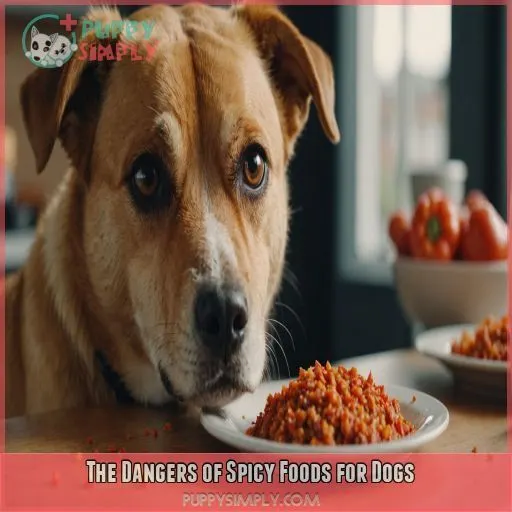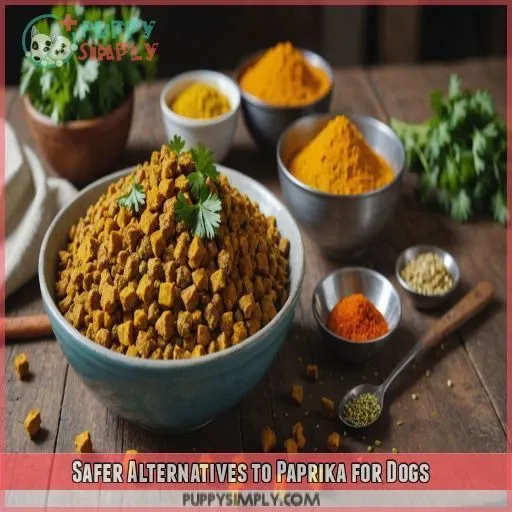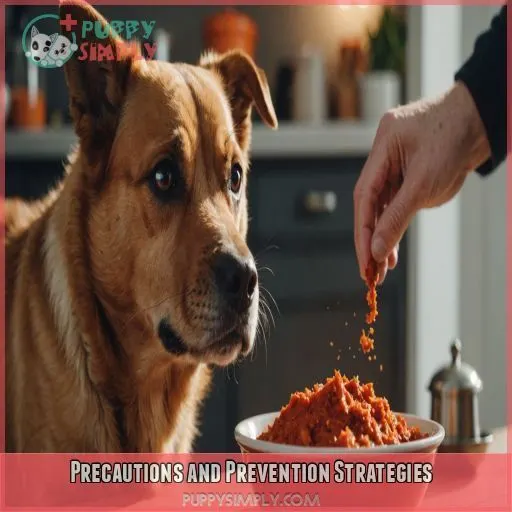This site is supported by our readers. We may earn a commission, at no cost to you, if you purchase through links.

While paprika isn’t downright toxic for dogs, it can turn their tummy into a turmoil land.
The innocent sprinkle you enjoy could leave Fido dealing with a bout of stomach upset, complete with vomiting and diarrhea.
Imagine that fiery feeling of eating too many spicy wings—no dog wants that!
Play it safe with pup-friendly herbs like basil or cilantro instead.
Your furball’s taste buds might thank you (in barks).
Curious about more canine culinary tips?
We’ve got you covered!
Table Of Contents
- Key Takeaways
- Can Dogs Eat Paprika Safely?
- What Happens if My Dog Eats Paprika?
- How Much Paprika is Too Much for My Dog?
- Dog-Safe Spices and Seasonings
- The Dangers of Spicy Foods for Dogs
- Can Dogs Have Salt, Pepper, and Paprika?
- Paprika and Potato Consumption in Dogs
- What to Do if Your Dog Accidentally Eats Paprika
- Safer Alternatives to Paprika for Dogs
- Precautions and Prevention Strategies
- Frequently Asked Questions (FAQs)
- What happens if my dog eats paprika?
- What spices dogs Cannot eat?
- Can dogs have salt pepper and paprika?
- Can dogs eat potatoes with paprika?
- Is paprika beneficial for dogs health?
- Can paprika affect a dogs sense of smell?
- What spices should be avoided for allergic dogs?
- Can paprika consumption impact a dogs behavior?
- Are certain dog breeds more sensitive to paprika?
- Conclusion
Key Takeaways
- Paprika’s No Picnic for Pups: While paprika isn’t downright toxic for your dog, it can lead to tummy turmoil for Fido, akin to hosting a mini chili-eating contest. Keep an eye out for carpet-worthy vomit and unscheduled sprints to the yard.
- Sniffing Out Spices: Your dog’s nose isn’t a fan of spicy parties. Paprika can cause sneezing and sniffles, though it won’t ruin their stellar sense of smell. Spicy isn’t always nice for your pup!
- Size Matters: Not all dogs react the same way – a tiny Chihuahua’s belly revolt might mirror a Pug’s. Breeds known for sensitive stomachs, like Bulldogs, could find paprika particularly potent.
- Opt for Pup-Friendly Flavors: If you’re looking to jazz up mealtime without the tummy tribulations, think of herbs like basil or cilantro. They bring a fresh twist, keeping tails wagging without the digestive drama.
Can Dogs Eat Paprika Safely?
If you’re thinking about giving your dog paprika, you’d be wise to tread cautiously; while it isn’t toxic, it might lead to some rather unpleasant stomach issues. Keep an eye on Fido if he manages to snag a taste, as you might find yourself dealing with a bit of a cleanup if his tummy doesn’t agree with this spicy seasoning.
Understanding the Risks of Paprika Ingestion
Regarding paprika and dogs, the risk lies mainly in its connection to chili peppers, which can lead to gastrointestinal upset. While not toxic, paprika can irritate your dog’s digestion. Stick to safer alternatives.
Common Signs and Symptoms of Paprika Poisoning
If your furry pal sneaks paprika, it might cause stomach upset, nausea, or worse. Watch for these signs:
- Vomiting – That sudden carpet redecorating.
- Diarrhea – Less fun than it sounds.
- Gas – Clearing rooms since forever.
- Loss of Appetite – Unusual for any foodie pup.
Factors Affecting Paprika Toxicity in Dogs
Although paprika is generally safe, its toxicity can vary based on the type, your dog’s size, and health. Spicy paprika with high chili pepper content poses greater risks if ingested in large amounts.
| Paprika Type | Dog Size | Dog Health |
|---|---|---|
| Sweet | Small | Sensitive |
| Smoked | Medium | Healthy |
| Spicy | Large | Robust |
What Happens if My Dog Eats Paprika?
If your dog eats paprika, it might feel like they’ve hosted a mini chili-eating contest in their belly. While it’s not toxic, expect possible stomach upset, and just hope they don’t decide to join the circus as a fire-breathing pooch.
Short-Term Effects of Paprika Ingestion
When Fido munches on paprika, an upset stomach might soon follow. You may notice:
- Vomiting: Your pup could paint the carpet Picasso-style.
- Diarrhea: A race against time to the backdoor begins.
- Respiratory issues: Sniffles and sneezes aren’t usual, but they can happen.
Keep paprika for yourself; dogs prefer safe treats!
Potential Long-Term Consequences of Paprika Consumption
Long-term paprika munching isn’t a day at the beach for your pooch. Think liver issues, digestive hiccups, or even allergies. Over time, paprika might mess with their coat’s shine or cause unwelcome weight gain. So, sticking to plain ol’ dog food and skipping the spicy red bell peppers keeps your pup in tail-wagging health.
How Much Paprika is Too Much for My Dog?
There’s no established safe dosage of paprika for dogs, so it’s best to avoid giving it to them altogether. While a small accidental ingestion is unlikely to cause serious harm, it’s important to monitor your pup closely for any signs of gastrointestinal distress.
Establishing a Safe Dosage for Paprika in Dogs
Determining a safe dosage of paprika for your dog is like walking a tightrope—it’s best to avoid it altogether. While paprika isn’t poisonous, its spice factor can lead to tummy troubles. If your dog sneaks a taste, keep an eye out for any symptoms, and consult your vet for peace of mind.
Factors Influencing Paprika Toxicity in Canines
You’ve probably wondered, "Can dogs eat paprika?" Well, don’t grab your paprika shaker just yet. Various factors influence paprika toxicity in canines. It depends on the paprika type, your dog’s breed, amount ingested, and chili pepper content. Just like some folks handle chili better, dogs have individual sensitivity, adding spice to their reactions!
Dog-Safe Spices and Seasonings
You don’t want to add paprika to your dog’s diet, but don’t worry, there are plenty of safe spices to choose from. Think of basil or chamomile as the herb equivalent of a dog’s wagging tail—simple, safe, and sure to please!
Exploring Alternatives to Paprika for Canine Diets
Rather than reaching for paprika, consider dog-friendly alternatives that add flavor without the risks. Herbs like basil, cilantro, and chamomile are safe options. You can also try sweet potatoes, beet root, or activated charcoal to season your pup’s meals. Explore these tasty, vet-approved substitutes for a healthier, happier dog.
Recommended Herbs and Spices for Dog Meals
Creating pup-approved meals is a walk in the park with dog-friendly seasonings. Here’s a handy table to spice up your furry friend’s life:
| Herb/Spice | Benefits | Safe Amount |
|---|---|---|
| Basil | Boosts mood | Pinch |
| Cilantro | Aids digestion | Pinch |
| Ginger | Eases nausea | Tiny slice |
| Chamomile | Calms nerves | Pinch |
| Anise | Stimulates appetite | Pinch |
The Dangers of Spicy Foods for Dogs
Spicy foods might be a delicious adventure for you, but they can spell trouble for your furry friend. Dogs can’t handle the heat like we do, and spicy foods can lead to a not-so-pleasant tummy rumble!
Understanding the Impact of Capsaicin on Canines
While experimenting with dog-safe spices, remember that capsaicin, found in paprika, can stir up quite a ruckus in your furry friend’s belly. Dogs aren’t wired to handle spice like us. Capsaicin sensitivity might trigger digestive issues and pain, as their metabolism struggles with spicy food reactions. Keep it mild!
Risks of Spicy Food Ingestion in Dogs
While spicy foods may tantalize our taste buds, they can wreak havoc on your pup’s delicate digestive system. Chili peppers and other fiery ingredients can cause intense stomach upset, vomiting, and diarrhea in canines. Steer clear of the spice rack to keep your furry friend safe and comfortable.
Can Dogs Have Salt, Pepper, and Paprika?
Spicy foods can be a dicey choice for dogs, much like getting into hot water without a lifeguard. Can dogs have salt, pepper, and paprika? While they won’t turn into superheroes with a sprinkle, these aren’t the safest options.
Paprika may lead to stomach upset, and pepper can irritate your dog’s nose and throat. And salt? Think “hold your horses”—too much could cause serious health issues.
Instead, consider these alternatives that are paw-sitively safer:
- Basil: A tasty herb with a subtle flavor.
- Chamomile: Known for its calming properties.
- Cilantro: Fresh and zesty in moderation.
- Cinnamon: Adds a sweet touch without the heat.
Paprika and Potato Consumption in Dogs
When you’re thinking about adding paprika to your dog’s potato dish, there’s a lot you should consider first. While potatoes can be a tasty treat for your pup, adding paprika might spice things up too much for their liking, potentially causing tummy troubles.
Risks and Benefits of Feeding Dogs Potatoes With Paprika
While some folks wonder about offering salt, pepper, and paprika to their furry pals, you might consider the risks of potato dishes seasoned with paprika. Dogs and paprika don’t always mix well, as the spice can upset their stomachs. Instead, try exploring spice alternatives that keep your dog’s tummy happy and safe.
Safe Preparation Methods for Paprika-Seasoned Potatoes
To safely serve paprika-seasoned potatoes to your pup, boil or bake the spuds without any seasonings. Once cooked, mash and mix in a small amount of dog-friendly herbs like parsley or basil. Avoid adding paprika or other spices that could upset your canine’s stomach.
What to Do if Your Dog Accidentally Eats Paprika
If your furry friend sneaks a taste of paprika, there’s no need to panic, but you should keep an eye out for any upset tummies. In this section, we’ll guide you on what steps to take if your pooch indulges in this spicy spice, when to watch them closely, and when it’s time to ring up your vet.
Immediate Steps for Paprika Ingestion in Dogs
If your dog munches on paprika-dusted potatoes, stay calm and think like a dog whisperer! First, don’t induce vomiting. It’s best to observe for any signs of distress. Monitor pup’s behavior closely—those puppy eyes might be deceiving. If symptoms show, keep your vet’s number handy. Keep spices safe and sound!
When to Seek Veterinary Attention for Paprika Poisoning
If your dog’s bright red aftermath includes persistent vomiting or severe diarrhea, it’s time for an urgent vet visit. Breathing difficulties are a big red flag, like spotting a wolf in sheep’s clothing. Remember, papilloma poisoning symptoms can sneak up unexpectedly, so trust your gut and call the vet if things seem amiss.
Safer Alternatives to Paprika for Dogs
While paprika may not be the best choice for your canine companion, there are plenty of delicious and nutritious alternatives to spice up your dog’s meals. From aromatic herbs like basil and cilantro to warming spices like cinnamon, you can easily find dog-friendly seasonings that will have your pup’s tail wagging.
Nutritious and Flavorful Options for Canine Diets
Looking for nutritious and flavorful options for your dog’s diet? Skip the paprika and try these:
- Dog food recipes that include lean meats and veggies for balanced meals.
- Homemade dog treats with oats and peanut butter.
- Nutritional supplements like omega-3 for shiny coats.
Your pooch’ll wag their tail in gratitude!
Recommended Dog-Friendly Herbs and Spices for Enhanced Taste
Spice up your pup’s meals with dog-safe herbs. They’re like seasoning superheroes waiting to add flavor without the drama of paprika. Check out these tasty options:
| Herb | Benefit |
|---|---|
| Basil | Antioxidant-rich |
| Parsley | Fresh breath |
| Dill | Aids digestion |
| Rosemary | Boosts memory |
| Ginger | Eases nausea |
With these safe seasoning tips, you’ll have a tasty, healthy dog-safe spice recipe in no time!
Precautions and Prevention Strategies
You probably know how your curious dog loves to sniff around the kitchen, but now’s the time to spice up pet safety by keeping paprika out of paw’s reach. Store those tempting jars of paprika and other spices safely, so your pup doesn’t whip up a stomachache in its culinary adventures.
Keeping Paprika and Spices Out of Reach of Dogs
Keeping paprika and other spices safely out of your pup’s reach is really important. Stash them in high cabinets, behind latched doors, or in sealed containers. Regularly check for any spills or dropped bits – dogs have a knack for sniffing them out! Proactively dog-proofing your kitchen helps prevent accidental ingestion.
Safe Storage and Handling of Spices in Dog-Owned Households
For kitchen safety, spice cabinet safety should top your list. For dog-proof storage, store spices up high or in secure spice storage containers. Remember, dogs are crafty and curious. Secure spice storage prevents accidents! With good planning, you’re more reliable than a steel trap in spice container tips!
Frequently Asked Questions (FAQs)
What happens if my dog eats paprika?
If your pup accidentally gobbles up some paprika, don’t panic! They may get a tummy ache, but it’s usually nothing serious. Just keep an eye on them and call the vet if symptoms persist or worsen.
What spices dogs Cannot eat?
You might love spicing up your meal, but regarding dogs, steer clear of spices like onion, garlic, nutmeg, and cocoa powder. These can be party crashers for your dog’s tummy and overall health!
Can dogs have salt pepper and paprika?
Think of spices as sneaky troublemakers: salt and pepper can harm your dog’s kidneys and GI tract, while paprika might upset their stomach. Keep your furry friend safe and skip them all during meal prep.
Can dogs eat potatoes with paprika?
Potatoes are fine for dogs, but skip the paprika. While it’s not toxic, paprika may upset your pup’s stomach. Stick to plain potatoes, and save the spices for your own plate to keep things safe!
Is paprika beneficial for dogs health?
Paprika isn’t really beneficial for your pup’s health. While not toxic, it can upset their tummy. It’s best to steer clear of feeding your dog paprika and stick to dog-safe seasonings instead. Your furry friend will thank you!
Can paprika affect a dogs sense of smell?
Coincidentally, dogs don’t lose their sense of smell from paprika, but their noses mightn’t appreciate the spice party. While not toxic, paprika can lead to sniffles or sneezes, so it’s best to keep it away.
What spices should be avoided for allergic dogs?
Avoid spices like garlic, onion, chives, and paprika for allergic dogs. These can stir up a storm in your dog’s tummy. When in doubt, consult your vet—it’s like having a lifesaver on speed dial!
Can paprika consumption impact a dogs behavior?
Paprika might cause your dog to act grumpy if it leads to an upset stomach. While it’s not toxic, your pup might become irritable due to nausea or discomfort. Keep an eye out for any changes.
Are certain dog breeds more sensitive to paprika?
While all dogs should avoid paprika, some pups may be more sensitive than others. Breeds with sensitive stomachs, like Pugs and Bulldogs, may be more prone to tummy troubles from this spice. Play it safe and keep paprika off the menu for your furry friend.
Conclusion
Figuring out your dog’s dietary delights shouldn’t include playing with fire.
A dash of paprika may lead to an inconvenient mess rather than a gourmet experience for your pooch.
While dogs can eat paprika, it might spice up their life a bit too much, potentially leading to an upset stomach.
Stick to pup-safe flavors like basil or cilantro to keep tails wagging.
Always keep spices out of paw’s reach and consult your vet if your furry friend explores paprika’s pantry.
















